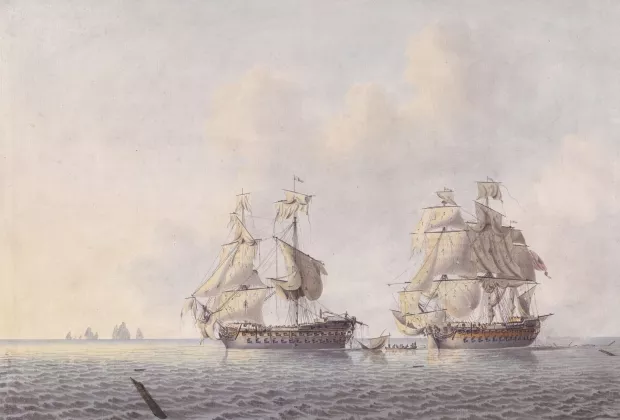Creation Date
1783
Height
34 cm
Width
51 cm
Medium
Genre
Description
Robert Cleveley was one of many marine artists hired by the navy to create paintings which were sold to the elite in British society. Many similar images were converted into prints and purchased by the general public (N. Tracy, Palette 5, 72). Two ships are portrayed in the center right of the image, a rowboat between them. The ship on the right is British, its flag displayed on the right side. It is more brightly colored and has more sails remaining than the ship on the left, which appears to be the conquered vessel. Pieces of shattered wood and rubble are scattered in the water surrounding the ships; one particularly prominent piece juts from the bottom edge of the picture into the left foreground.
Cleveley was one of many marine artists hired by the navy to create paintings like An English Man-of-War Taking Possession of a Ship, which were then sold to the elite of British society. Many similar images were converted into prints and purchased by the general public (Tracy 5, 72). He uses light to further emphasize the figures of the two foremost ships. The horizon is deeply shadowed, as are the ships disappearing into it. The melding of the distant ships with the horizon line impresses upon the viewer the vastness of the continuing sea, and so alludes to the sublime. The faint visibility of these ships encountering the sublime implies the power of the British navy to extend imperial control over distant seas and lands. However, John Williams’s comparison of Cleveley’s work with de Loutherbourg's reveals the value that was placed on the accuracy, and thus the “truth,” of a work as well as its ability to “impress” viewers with the Romantic and dramatic elements more explicit in pieces like Battle of the Glorious First of June. The desire to maintain accuracy in marine paintings can be related to the national pride associated with these images: Williams's emphasis on a "correct" image devoid of theatrical effects may imply the assumption that British naval power was powerful and artistically valuable in and of itself, and so did not require the kind of exaggeration employed by de Loutherbourg.
Copyright
Copyright, 2009, Yale Center for British Art, Paul Mellon Collection
Collection
Accession Number
B1975.4.1476
Additional Information
Bibliography
Bénézit, E., et al. "Cleveley, Robert." Benezit Dictionary of Artists. Paris: Gründ, 2006. Print.
The American Naval and Patriotic Songster. Baltimore, 1831. Print.
Tracy, Nicholas. Britannia's Palette: The Arts of Naval Victory. Montreal: McGill-Queen's UP, 2007. Print.
Yale Center for British Art

